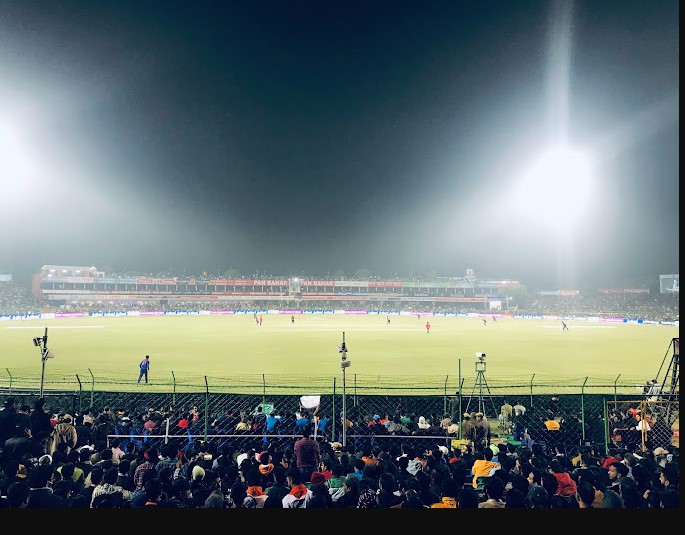Sawai Mansingh Stadium, located in the heart of Jaipur, Rajasthan, is a prominent cricket venue in India. Over the years, it has earned a reputation for its vibrant atmosphere, enthusiastic crowds, and a rich history of hosting both international and domestic matches, including Indian Premier League (IPL) games. While the stadium is famous for its atmosphere, the dimensions of the playing field, particularly the boundary lengths, also play a crucial role in determining the nature of the game. In this article, we will explore the boundary lengths of Sawai Mansingh Stadium, their impact on cricketing strategies, and how it compares to other cricket grounds in India.
Table of Contents
Introduction to Sawai Mansingh Stadium
Sawai Mansingh Stadium, named after Maharaja Sawai Mansingh II of Jaipur, was established in 1969. The stadium has hosted a wide range of domestic and international matches, including ODIs, T20s, and Test matches. With a capacity of around 30,000 spectators, it provides an electric atmosphere during matches, particularly in the IPL. As one of the major cricketing venues in Rajasthan, the stadium plays a vital role in Indian cricket, but its playing dimensions, especially its boundary lengths, add another layer of intrigue.
Boundary Dimensions of Sawai Mansingh Stadium
The boundary lengths of any cricket ground significantly influence the style of play. Shorter boundaries generally favor the batsmen, leading to more sixes and higher scores. On the other hand, longer boundaries can make it more challenging for batsmen to clear the ropes, often resulting in a more tactical approach to batting.
At Sawai Mansingh Stadium, the boundary dimensions are relatively standard compared to some other major Indian stadiums. The lengths vary slightly depending on the specific area of the ground, but on the whole, they provide a balanced challenge for both batsmen and bowlers. Below is a breakdown of the boundary lengths:
| Boundary Type | Length (Meters) |
|---|---|
| Straight Boundary | 75 – 80 |
| Square Boundary | 65 – 70 |
| Fine Leg Boundary | 66 |
| Third Man Boundary | 66 |
These measurements are essential in understanding the tactical approach to cricket at Sawai Mansingh Stadium. The straight boundary, which spans 75 to 80 meters, is considerably long compared to other grounds with shorter straight boundaries. However, the square boundaries are more compact, ranging between 65 and 70 meters, making it easier for batsmen to target boundaries square of the wicket. Additionally, the fine leg and third man boundaries are both set at approximately 66 meters, which are quite balanced for both batsmen and bowlers.
Impact of Boundary Dimensions on Gameplay
The boundary lengths at Sawai Mansingh Stadium influence the gameplay significantly. These dimensions favor a more well-rounded approach to batting and bowling. Here’s how:
For Batsmen:
- The longer straight boundaries (75-80 meters) challenge batsmen to use more power to hit sixes, especially in the longer format of the game. This requires batsmen to time the ball well and find the gaps, rather than simply relying on power hitting.
- The square boundaries, however, are relatively shorter (65-70 meters), which gives batsmen an opportunity to target the areas behind square on the off-side and leg-side with more ease. This makes the ground more conducive to boundaries in the shorter formats, particularly T20s.
For Bowlers:
- Bowlers benefit from the longer straight boundaries, as it gives them more space to bowl length balls or slower deliveries, reducing the likelihood of batsmen clearing the boundary with ease.
- The shorter square boundaries do present a challenge, as they are more likely to be targeted for boundaries. However, a bowler can strategize with field placements and variations in pace and spin to make the batsman play into the longer regions of the ground.
Tactical Play:
- Teams often choose to set their field placements depending on these dimensions. For example, bowlers may prefer to bowl with a field set to encourage the batsmen to play towards the longer boundary.
- The shorter square boundaries are often targeted by aggressive players who look to capitalize on gaps behind square, making placement and timing crucial.
Historical Context and Record-Breaking Matches
Over the years, Sawai Mansingh Stadium has seen several thrilling encounters. Some matches have been particularly memorable due to the boundary dimensions influencing high scores and explosive performances. For example, in the IPL, the Rajasthan Royals have made full use of the shorter square boundaries, with players such as Shane Warne and Rahul Dravid being prominent figures at this venue.
Furthermore, the ground’s dimensions have been integral in games that feature power hitters. The stadium’s history of hosting high-scoring games is partly due to the combination of these boundary lengths and the conditions that encourage aggressive batting.
Comparison with Other Indian Stadiums
To understand how Sawai Mansingh Stadium compares to other famous cricket grounds in India, let’s take a look at how its boundary dimensions stack up against some other prominent venues:
| Stadium Name | Straight Boundary (Meters) | Square Boundary (Meters) | Fine Leg/Third Man Boundary (Meters) |
|---|---|---|---|
| Sawai Mansingh Stadium | 75 – 80 | 65 – 70 | 66 |
| Eden Gardens, Kolkata | 70 – 75 | 65 – 70 | 65 – 70 |
| Wankhede Stadium, Mumbai | 55 – 60 | 60 – 65 | 60 – 65 |
| Narendra Modi Stadium, Ahmedabad | 75 – 80 | 70 – 75 | 70 – 75 |
From the comparison, it is evident that Sawai Mansingh Stadium’s straight boundaries (75-80 meters) are larger than those at Wankhede Stadium in Mumbai, which has straight boundaries ranging from 55 to 60 meters. However, the square boundaries are more or less similar to other major grounds in India, making it a relatively balanced ground overall.
In conclusion, the boundary lengths of Sawai Mansingh Stadium play a significant role in the style of cricket played at this venue. The longer straight boundaries make it challenging for batsmen to clear the ropes, while the shorter square boundaries encourage more aggressive stroke play. This blend of dimensions creates a balanced environment where both batsmen and bowlers must use skill and strategy to succeed.
The historical significance of Sawai Mansingh Stadium, combined with its unique boundary dimensions, makes it an exciting venue for cricket enthusiasts. Whether it’s a high-scoring IPL match or an intense international encounter, the dimensions of the ground play a crucial role in shaping the outcome of the game.
As the game of cricket continues to evolve, the impact of boundary dimensions remains a key aspect of ground strategy. Sawai Mansingh Stadium’s balanced dimensions ensure that every match played here is full of excitement, with players constantly adapting to the challenges posed by this iconic venue.

